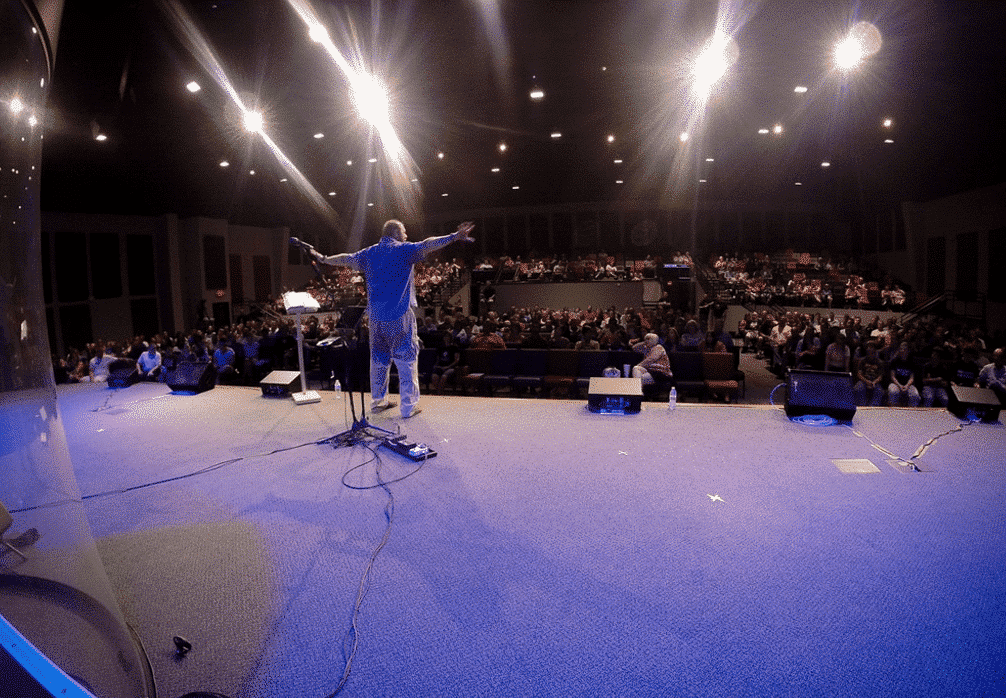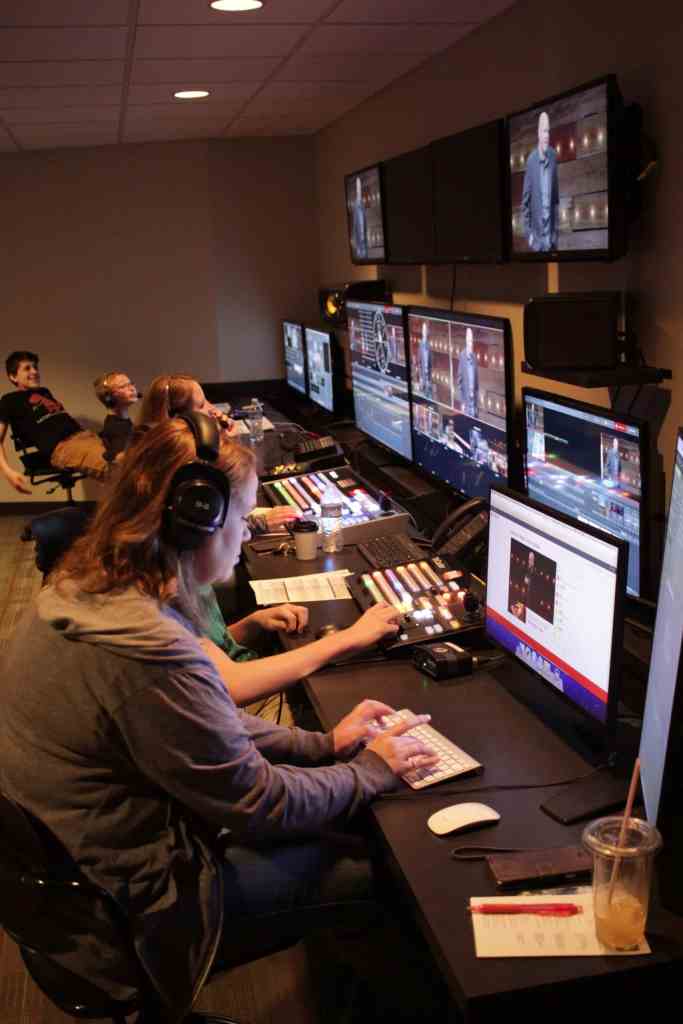Through the power of video, CrossPoint Church in Hutchinson, Kansas has connected nearly a dozen church campuses across the state with professional HD video productions of weekly worship messages. With churches around the country facing closures due to shrinking budgets, CrossPoint is enabling churches on the verge of shuttering their doors to stay open.
“In Kansas, there are many small communities that have churches that are closing,” said Paul Alicea, CrossPoint Worship Arts Pastor. “Our production technology and process enables us to get into those communities that have smaller churches, or may no longer have access to a place of worship.”

10 years ago, Andy Addis, Lead Pastor at CrossPoint, originally came up with the idea of recording their services to share with other church campuses, and Alicea carried out the production. It has since grown into a large growth opportunity for CrossPoint.
Two years ago the church moved into a new building in Hutchinson, which now serves as the main CrossPoint campus. With the capacity to welcome 2,000 people per weekend and production housed in one location, they began doing three services total: one Saturday and two on Sunday.
Every Saturday night the Hutchinson main campus holds a live music worship and message, and Alicea captures the service in a variety of ways to share with the online community and other campuses. On Sundays, they live-stream the services on their website for community members that can’t attend.
“We have people who are regular attendants here, but for whatever reason, if they have to miss a week, they can still feel involved,” said Alicea. “The goal here is to reach people in more rural parts of Kansas who don’t physically attend a church. This is their church.”
For archiving purposes, the production team records all three services, but the Saturday night service is produced in post and sent out to the other campuses for Sunday services, taking the place of music and a live pastor.
“Our production quality is as good as anything you would see on TV, which helps members feel what the people are feeling in the live setting,” said Alicea.

**Fostering an Online Congregation **
CrossPoint relies on Life Church.TV to stream video to each of the campuses. The platform allows multiple bandwidth streaming options, which has been perfect for campuses that don’t have access to the highest bandwidth.
“On a regular basis, I hear people say, ‘I love that I can take care of my sick kid at home, and still feel connected to the church,’” said Alicea.
Through Life Church.TV, CrossPoint can also incorporate clickable banners for giving or volunteering, and a button to connect with a live prayer partner. During the time of worship, lyrics to the songs are also displayed so people can follow along.
“The neat thing about this is that remote viewers can see what’s happening right here—child dedications, baptisms—everything is covered live,” said Alicea. “People online can participate in what we’re doing.”
Once the video portion of the production was solidly established, CrossPoint began working to enhance its audio. The church now splits the sound and has a person specifically dedicated to running audio for every video. That person controls the mix of the band, vocals, and everything seen and heard on the video.
Not only does it look good and sound good, it also takes very little time to do post-production of the videos to deliver them to the other campuses and to upload to the CrossPoint archive. The beauty of using TriCaster for switching during each service is that Alicea only needs to clean up some ends, render the video, and then upload.
“If we do our jobs correctly, I do very little. I just clean it up and make sure the audio sounds good,” said Alicea. “If I need to add in some graphics or video, that’s not a problem. It really doesn’t take me very long to do that.”
**Workflow **
CrossPoint church uses three TriCasters: the TriCaster 8000, the TriCaster 460, and the TriCaster 410. With a total of twelve crewmembers on a regular weekend service, the responsibilities are parsed out so each person can concentrate on one task. Although most of the desired production can be accomplished with just one TriCaster, Alicea designated specific roles for each machine, making it easy for any of the church volunteers to perform, and keeping more members of the congregation involved in the production.
“I like the consistency of having the same mentality every time we produce a video. Everyone who is serving, serves the entirety of the weekend,” said Alicea. “Everything stays the same for each service, which is easier than trying to change things between each service. It keeps everyone in the habit of staying on guard, so to speak, and keeps everyone engaged.”

A total of six cameras feed into the TriCaster 8000: 3 manned Panasonic AG-HPX370 cameras and 3 Panasonic AW-HE60 PTZ cameras. There is a control bunker in the church, where the camera director sits, along with a person who does all their shading, and another who controls the PTZ cameras. HDMI feeds for all of the cameras are routed through a BlackMagic Compact Video Hub.
The TriCaster 460 takes the program directly out of the 8000, which is used to switch their side screen and display video and graphics like keyed lyrics for the live congregation in the church.
To produce the program for other campuses, Alicea pulls the video from the 8000 and using Premiere on his MacBook Pro, adds in some slides and lower thirds, along with beginnings and ends for a professional touch.
The TriCaster 410 acts as their capture machine to record and is also their streaming machine. They take the program out of both the 8000 and the 410 and add specific graphics and overlays for the online stream like Twitter comments, Instagram photos, and lower thirds. The online stream is more interactive than the videos produced for Sunday services, so Alicea aims to make it faster paced for viewers.
In the front of house, they use a Yamaha CL-5 audio mixer. IP-based audio software Dante Audio runs through the TriCaster 8000, and is mixed with a smaller Yamaha for the stage band and to record the message – for the highest quality audio recording. With no merging or matching of audio waves required, the software enables CrossPoint to deliver great sound. Instead of running physical hardline as a backup, Alicea runs a software hardline that matches all audio channels, along with an Ethernet cable in order to route audio to whatever location they want.

Equipment
- TriCaster 8000 – Primary job is to live switch all cameras
- TriCaster 460 – primary job is to switch side screen for live services (IMAG, slides, video, overlays, dsk)
- TriCaster 410 – primary job is to capture recording for the other campuses and to live stream.
- Cameras: Panasonic AG-HPX370 x 3 and Panasonic AW-HE60 PTZ x3 with Panasonic AW-RP50 Controller
- Camera Shading: Panasonic AG-EC4 x3
- Routing: HD/SDI to BlackMagic Compact Video Hub 40×40 Audio:
- Yamaha CL-5 FOH
- Yamaha LS-9/16 mix monitor, Audio for Video
- All audio is routed via Dante Audio
- Light Cast Media as stream delivery provider – for upload and archive. If the stream goes down it goes to an archive.




















